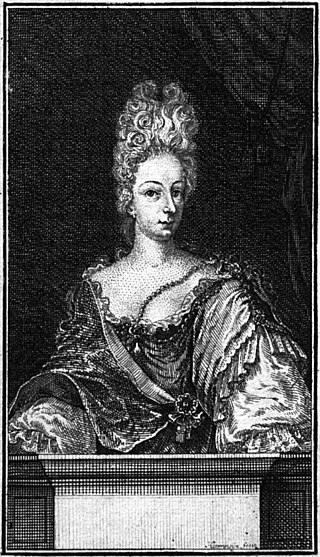
The decimal numeral system is the standard system for denoting integer and non-integer numbers. It is the extension to non-integer numbers of the Hindu–Arabic numeral system. The way of denoting numbers in the decimal system is often referred to as decimal notation.

Simon Stevin, sometimes called Stevinus, was a Flemish mathematician, scientist and music theorist. He made various contributions in many areas of science and engineering, both theoretical and practical. He also translated various mathematical terms into Dutch, making it one of the few European languages in which the word for mathematics, wiskunde, was not a loanword from Greek but a calque via Latin. He also replaced the word chemie, the Dutch for chemistry, by scheikunde, made in analogy with wiskunde.

Marie-Jeanne "Manon" Roland de la Platière, born Marie-Jeanne Phlipon, and best known under the name Madame Roland was a French revolutionary, salonnière and writer. Her letters and memoirs became famous for recording the state of mind that conditioned the events leading to the revolution.

Antonin Nompar de Caumont, 1st Duke of Lauzun was a French courtier and soldier. He was the only love interest of the "greatest heiress in Europe", Anne Marie Louise d'Orléans, Duchess of Montpensier, cousin of Louis XIV.

Adrien Maurice de Noailles, 3rd Duke of Noailles was a French nobleman and soldier.

Jacques Nompar de Caumont, 1st Duke of La Force was a Marshal of France and Peer of France. He was the son of a Huguenot, Francois de Caumont, lord of Castelnau, and Philippe de Beaupoil. He survived the St. Bartholomew's Day Massacre in 1572, but his father and older brother Armand were killed.

Marie de Gournay was a French writer, who wrote a novel and a number of other literary compositions, including The Equality of Men and Women and The Ladies' Grievance. She insisted that women should be educated. Gournay was also an editor and commentator of Michel de Montaigne. After Montaigne's death, Gournay edited and published his Essays.

Marie Madeleine de Vignerot, suo jure Duchess of Aiguillon was a French aristocrat, also remembered for her charitable work and her patronage of artists and mathematicians.

Henriette-Julie de Murat was an aristocratic French writer of the late 17th century, associated with the Baroque Précieuses movement, and one of the leading members of the French Salons who created the fairy tale genre.
Charlotte-Rose de Caumont de La Force, Charlotte-Rose Caumont La Force, or Mademoiselle de La Force (1654–1724) was a French novelist and poet. Her best-known work was her 1698 fairy tale Persinette which was adapted by the Brothers Grimm in 1812 as the story Rapunzel.

Armand Nompar de Caumont, 2nd Duke of La Force was a Marshal of France and peer of France. He was the son of another Marshal of France, Jacques-Nompar de Caumont, duc de La Force and Charlotte de Gontaut, daughter of Marshal Armand de Gontaut, baron de Biron. Like his father, Armand-Nompar was a Huguenot Protestant.

Henri Nompar de Caumont, 3rd Duke of La Force was Duc de La Force and peer of France. He was the son of Marshal of France, Jacques-Nompar de Caumont, duc de La Force and Charlotte de Gontaut, daughter of Marshal Armand de Gontaut, baron de Biron. First marquis de Castelnau, later Duc de La Force after the death of his brother, he served King Louis XIII on many occasions in the army, under his father, as Maréchal-de-camp.

Countess Elisabeth of Nassau was the second daughter of prince William of Orange and his third spouse Charlotte of Bourbon, and Duchess of Bouillon by marriage to Henri de La Tour d'Auvergne. She was the regent of Sedan during the absence of her spouse; between 1623 and 1626 during the minority of her son; and from 1632 during the absence of her son.

Ghiyāth al-Dīn Jamshīd Masʿūd al-Kāshī was an astronomer and mathematician during the reign of Tamerlane.
Marie Louise de Rohan, also known as Madame de Marsan, was the governess of Louis XVI of France and his siblings. She was an influential figure of the French court and a driving force of the Dévots and the conservative fraction of the court nobility.
A timeline of numerals and arithmetic.
This is a timeline of pure and applied mathematics history. It is divided here into three stages, corresponding to stages in the development of mathematical notation: a "rhetorical" stage in which calculations are described purely by words, a "syncopated" stage in which quantities and common algebraic operations are beginning to be represented by symbolic abbreviations, and finally a "symbolic" stage, in which comprehensive notational systems for formulas are the norm.

Baroness Francoise Charlotte Amable d'Aubigne-Maintenon, Duchess of Noailles was a French aristocrat, the wife of Adrien Maurice de Noailles, 3rd Duke of Noailles. She was the niece of Françoise d'Aubigné, Madame de Maintenon, and her heiress.
De Thiende, published in 1585 in the Dutch language by Simon Stevin, is remembered for extending positional notation to the use of decimals to represent fractions. A French version, La Disme, was issued the same year by Stevin.
Louise-Victoire de La Force (1665-1722), was a French courtier. She was the first lover of Louis, Dauphin of France.














